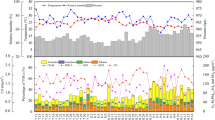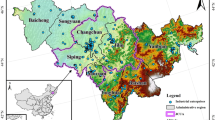Abstract
This study estimates the detailed chemical profiles of China’s anthropogenic volatile organic compounds (VOCs) emissions for the period of 2005–2020. The chemical profiles of VOCs for seven activity sectors are calculated, based on which the Photochemical Ozone Creation Potential (POCP) of VOCs for these sectors is evaluated. At the national level, the VOCs species emitted in 2005 include alkanes, alkenes and alkynes, aromatic compounds, alcohols, ketones, aldehydes, esters, ethers and halocarbons, accounting for 26.4 wt.%, 29.2 wt.%, 21.3 wt.%, 4.7 wt.%, 5.4 wt.%, 1.7 wt.%, 2.1 wt.%, 0.7 wt. % and 2.2 wt.% of total emissions, respectively. And during 2005-2020, their mass proportions would respectively grow or decrease by − 6.9%, − 32.7%, 7.3%, 65.3%, 34.7%, − 48.6%, 108.5%, 100.5%, and 55.4%. This change would bring about a 13% reduction of POCP for national VOCs emissions in the future. Thus, although the national VOCs emissions are expected to increase by 33% over the whole period, its ozone formation potential is estimated to rise only by 14%. Large discrepancies are found in VOCs speciation emissions among provinces. Compared to western provinces, the eastern provinces with a more developed economy would emit unsaturated hydrocarbons and benzene with lower mix ratios, and aromatic compounds except benzene, oxidized hydrocarbons and halocarbons with higher mix ratios. Such differences lead to lower POCP of VOCs emitted in eastern provinces, and higher POCP of VOCs emitted in western provinces. However, due to the large VOCs emissions from Chinese eastern region, the ozone formation potential of VOCs emission in eastern provinces would be much higher than those in western provinces by about 156%–235%.
Similar content being viewed by others
References
Wang H X, Kiang C S, Tang X Y, Zhou Z J, Chameides W L. Surface ozone: a likely threat to crops in Yangtze delta of China. Atmospheric Environment, 2005, 39(21): 3843–3850
Coleman B K, Lunden M M, Destaillats H, Nazaroff W W. Secondary organic aerosol from ozone-initiated reactions with terpene-rich household products. Atmospheric Environment, 2008, 42(35): 8234–8245
Lamorena R B, Lee W. Influence of ozone concentration and temperature on ultra-fine particle and gaseous volatile organic compound formations generated during the ozone-initiated reactions with emitted terpenes from a car air freshener. Journal of Hazardous Materials, 2008, 158(2–3): 471–477
Lin S, Bell EM, Liu W, Walker R J, Kim N K, Hwang S A. Ambient ozone concentration and hospital admissions due to childhood respiratory diseases in New York State, 1991–2001. Environmental Research, 2008, 108(1): 42–47
van Zelm R, Huijbregts M A J, den Hollander H A, van Jaarsveld H A, Sauter F J, Struijs J, van Wijnen H J, van de Meent D. European characterization factors for human health damage of PM10 and ozone in life cycle impact assessment. Atmospheric Environment, 2008, 42(3): 441–453
Pei C H. Air pollution control in Bei**g. In: Procrrdings of Conference on strategic approaches to regional air quality management in China. Bei**g: 2005
Shao M, Tang X Y, Zhang Y H, Li W. City clusters in China: air and surface water pollution. Frontiers in Ecology and the Environment, 2006, 4(7): 353–361
Ding A J, Wang T, Thouret V, Cammas J P, Nédélec P. Tropospheric ozone climatology over Bei**g: analysis of aircraft data from the MOZAIC program. Atmospheric Chemistry and Physics, 2008, 8(1): 1–13
Geng F H, Tie X X, Xu J M, Zhou G, Peng L, Gao W, Tang X, Zhao C. Characterizations of ozone, NOx, and VOCs measured in Shanghai, China. Atmospheric Environment, 2008, 42(29): 6873–6883
Wang T, Wei X L, Ding A J, Poon C N, Lam K S, Li Y S, Chan L Y, Anson M. Increasing surface ozone concentrations in the background atmosphere of Southern China, 1994–2007. Atmospheric Chemistry and Physics, 2009, 9(16): 6217–6226
Streets D G, Fu J S, Jang C J, Hao J, He K, Tang X, Zhang Y, Wang Z, Li Z, Zhang Q, Wang L, Wang B, Yu C. Air quality during the 2008 Bei**g Olympic Games. Atmospheric Environment, 2007, 41(3): 480–492
Xu J, Zhang Y H, Fu J S, Zheng S, Wang W. Process analysis of typical summertime ozone episodes over the Bei**g area. Science of the Total Environment, 2008, 399(1–3): 147–157
Zhang Y H, Su H, Zhong L J, Cheng Y F, Zeng L M, Wang X S, **ang Y R, Wang J L, Gao D F, Shao M. Regional ozone pollution and observation-based approach for analyzing ozone-precursor relationship during the PRIDE-PRD2004 campaign. Atmospheric Environment, 2008, 42(25): 6203–6218
Shao M, Zhang Y H, Zeng L M, Tang X, Zhang J, Zhong L, Wang B. Ground-level ozone in the Pearl River Delta and the roles of VOC and NO(x) in its production. Journal of Environmental Management, 2009, 90(1): 512–518
Cheng H R, Guo H, Saunders SM, Lam S H M, Jiang F, Wang XM, Simpson I J, Blake D R, Louie P K K, Wang T J. Assessing photochemical ozone formation in the Pearl River Delta with a photochemical trajectory model. Atmospheric Environment, 2010, 44(34): 4199–4208
Tonooka Y, Kannari A, Higashino H, Murano K. NMVOCs and CO emission inventory in East Asia. Water, Air, and Soil Pollution, 2001, 130(1/4): 199–204
Klimont Z, Streets D G, Gupta S, Cofala J, Lixin F, Ichikawa Y. Anthropogenic emissions of non-methane volatile organic compounds in China. Atmospheric Environment, 2002, 36(8): 1309–1322
Streets D G, Bond T C, Carmichael G R, Fernandes S D, Fu Q, He D, Klimont Z, Nelson S M, Tsai N Y, Wang M Q, Woo J H, Yarber K F. An inventory of gaseous and primary aerosol emission in Asia in the year 2000. Journal of Geophysical Research, 2003, 108(D21): 8809–8832
Bo Y, Cai H, **e S D. Spatial and temporal variation of emission inventories for historical anthropogenic NMVOCs in China. Atmospheric Chemistry and Physics Discussion, 2008, 8(23): 1519–1566
Liu J F, Zhao J, Li T T, Bai Y H, Liu Z R. Establishment of Chinese anthropogenic source volatile organic compounds emission inventory. China Environmental Science, 2008, 28(6): 496–500 (In Chinese)
Wei W, Wang S X, Chatani S, Klimont Z, Cofala J, Hao J. Emission and speciation of non-methane volatile organic compounds from anthropogenic sources in China. Atmospheric Environment, 2008, 42(20): 4976–4988
Wei W, Wang S X, Hao J M, Cheng S. Projection of anthropogenic volatile organic compounds (VOCs) emissions in China for the period 2010–2020. Atmospheric Environment, 2011, 45(38): 6863–6871
Derwent R G, Jenkin M E, Passant N R, Pilling M J. Photochemical ozone creation potentials (POCPs) for different emission sources of organic compounds under European conditions estimated with a Master Chemical Mechanism. Atmospheric Environment, 2007, 41(12): 2570–2579
Liu X H, Zhang Y, Cheng S H, **ng J, Zhang Q, Streets D G, Jang C, Wang W X, Hao J M. Understanding of regional air pollution over China using CMAQ, part I performance evaluation and seasonal variation. Atmospheric Environment, 2010, 44(20): 2415–2426
Altenstdet J, Pleijel K. POCP for individual VOC under European Condition [R]. IVL Swedish Environmental Research Institute. 1998
Zhang Q, Streets D G, He K B, Wang Y X, Richter A, Burrows J P, Uno I, Jang C J, Chen D, Yao Z L, Lei Y. NOx emission trends for China, 1995–2004: The view from the ground and the view from space. Journal of Geophysical Research, 2007, 112(D2): 1–18
Wang S X, **ng J, Chatani S, Hao J, Klimont Z, Cofala J, Amann M. Verification of anthropogenic emissions of China by satellite and ground observations. Atmospheric Environment, 2011, 45(35): 6347–6358
Huang C, Chen C H, Li L, Cheng Z, Wang H L, Huang H Y, Streets D G, Wang Y J, Zhang G F, Chen Y R. Emission inventory of anthropogenic air pollutants and VOC species in the Yangtze River Delta region, China. Atmospheric Chemistry and Physics, 2011, 11(9): 4105–4120
Wang S X, Wei W, Du L, Li G, Hao J. Characteristics of gaseous pollutants from biofuel-stoves in rural China. Atmospheric Environment, 2009, 43(27): 4148–4154
Zhang J F, Smith K R, Ma Y, Ye S, Jiang F, Qi W, Liu P, KhalilMA K, Rasmussen R A, Thorneloe S A. Greenhouse gases and other airborne pollutants from household stoves in China. Atmospheric Environment, 2000, 34(26): 4537–4549
Liu Y, Shao M, Fu L L, Lu S, Zeng L, Tang D. Source profiles of volatile organic compounds (VOCs) measured in China: Part I. Atmospheric Environment, 2008, 42(25): 6247–6260
Fu L L, Shao M, Liu Y, Liu Y, Lu S H, Tang D G. Tunnel experimental study on the emission factors of volatile organic compounds (VOCs) from vehicles. Acta Scientiae Circumstantiae, 2005, 25(7): 879–885 (in Chinese)
Liang B S, Zhou Y. Study on emission characteristics of volatile organic compounds in the exhaust of different types of vehicles. Environmental Monitoring in China, 2005, 21(1): 8–11 (in Chinese)
Yuan B, Shao M, Lu S H, Wang B. Source profiles of volatile organic compounds associated with solvent use in Bei**g, China. Atmospheric Environment, 2010, 44(15): 1919–1926
He Q S, Wang XM, Zhao L R, Sheng G Y, Fu JM. Preliminary study on profiles of VOCs emitted from coking. Environmental Monitoring in China, 2005, 21(1): 61–66 (in Chinese)
Cheng P, ZhangW J, Chu Y N. Analysis of Petrol and Diesel Vapor Using Selective Ion Flow Tube/Mass Spectrometry. Chinese Journal of Analytical Chemistry, 2003, 31(5): 548–551 (in Chinese)
Lu S H, Bai Y H, Zhang G S, M J. Study on the characteristics of VOCs source profiles of vehicle exhaust and gasoline emission. Acta Scientiarum Naturalium Universitatis Pekinensis, 2003, 39(4): 507–512 (in Chinese)
**e J X. A study of the indoor air organic pollution affected by environment tobacco smoke. Desseration for the Doctoral Degree. Guangzhou: Graduate University of Chinese Academy of Science, 2004 (in Chinese)
Author information
Authors and Affiliations
Corresponding author
Rights and permissions
About this article
Cite this article
Wei, W., Wang, S., Hao, J. et al. Trends of chemical speciation profiles of anthropogenic volatile organic compounds emissions in China, 2005–2020. Front. Environ. Sci. Eng. 8, 27–41 (2014). https://doi.org/10.1007/s11783-012-0461-4
Received:
Accepted:
Published:
Issue Date:
DOI: https://doi.org/10.1007/s11783-012-0461-4




